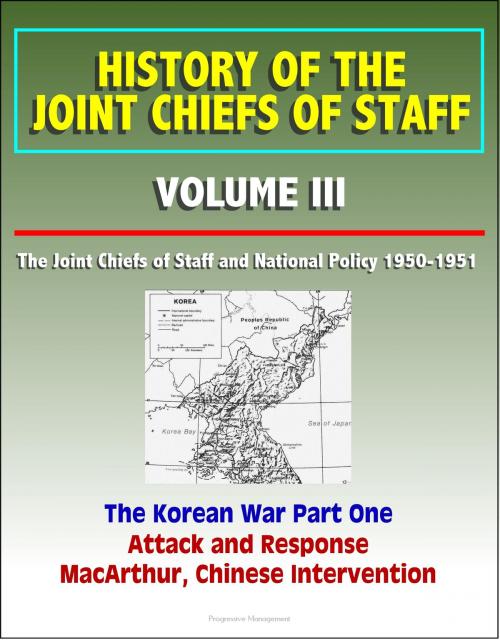History of the Joint Chiefs of Staff: Volume III: The Joint Chiefs of Staff and National Policy 1950 - 1951, The Korean War Part One - Attack and Response, MacArthur, Chinese Intervention
Nonfiction, History, Asian, Korean War, Military| Author: | Progressive Management | ISBN: | 9781301769612 |
| Publisher: | Progressive Management | Publication: | September 17, 2013 |
| Imprint: | Smashwords Edition | Language: | English |
| Author: | Progressive Management |
| ISBN: | 9781301769612 |
| Publisher: | Progressive Management |
| Publication: | September 17, 2013 |
| Imprint: | Smashwords Edition |
| Language: | English |
Established during World War II to advise the President regarding the strategic direction of armed forces of the United States, the Joint Chiefs of Staff (JCS) continued in existence after the war and, as military advisers and planners, have played a significant role in the development of national policy. Knowledge of JCS relations with the President, the National Security Council, and the Secretary of Defense in the years since World War II is essential to an understanding of their current work. An account of their activity in peacetime and during times of crisis provides, moreover, an important series of chapters in the military history of the United States.
At the time it was fought, the war in Korea was unique in recent American military experience. Unlike World Wars I and II, which were vigorously prosecuted on the battlefield until the enemy surrendered unconditionally, the Korean conflict ended without clear-cut military victory for either side. It was fought with limited means for limited objectives. In fact, political efforts to resolve the conflict at the negotiating table predominated during the last two years of the conflict. During this period, neither side sought a decision by military means.
The conflict in Korea also was an important milestone in the "cold war" relations between the Communist and non-Communist nations. By launching an unprovoked attack on a militarily insignificant country located in an area where none of their vital interests were involved, the Communists appeared to leaders of the non-Communist states to be giving proof of their aggressive designs for world domination. As a result, the United States reversed the policy of reducing its military establishment and launched an impressive expansion of its armed forces. At the same time, the United States joined with its North Atlantic Treaty Organization (NATO) partners to create a military command for the alliance and to incorporate German forces in it. In the Far East, the United States also acted to shore up the defenses of the non-Communist world by entering into treaties with Australia and New Zealand, the Philippines, Japan, South Korea, and Nationalist China.
The Korean War provided the first wartime test for the Joint Chiefs of Staff, acting as part of the machinery set up by the National Security Act of 1947 and its 1949 amendment. In this capacity, they provided strategic direction to the United Nations (UN) forces in the field and were the agency by which President Truman exercised overall control of war strategy. When the focus shifted from combat to armistice negotiations, the Joint Chiefs of Staff continued to play an active role. They participated in all the key decisions taken during negotiations, and they provided the channel of communications between the Government in Washington and Commander in Chief, United Nations Command (CINCUNC), and his armistice negotiating team in Korea.
The focus of this volume is, naturally, on the Joint Chiefs of Staff. But as they were not acting in a vacuum, it has been necessary to describe the context in which they functioned. To this end, the actions of the President and the Secretaries of State and Defense concerning overall military strategy and armistice negotiations have been described in some detail. In addition, the consequences of these actions, on the battlefield and at the negotiating table, have been sketched in broad outline.
- Korea in US Policy, 1945-1950 * 2. The Attack and the Response * 3. The United States and the United Nations * 4. The Buildup and the Strategy * 5. The Conflict Almost Won * 6. A Time of Uncertainty * 7. The New War * 8. The UN Command in the Balance * 9. The Conflict Stabilized * 10. The Relief of General MacArthur
Established during World War II to advise the President regarding the strategic direction of armed forces of the United States, the Joint Chiefs of Staff (JCS) continued in existence after the war and, as military advisers and planners, have played a significant role in the development of national policy. Knowledge of JCS relations with the President, the National Security Council, and the Secretary of Defense in the years since World War II is essential to an understanding of their current work. An account of their activity in peacetime and during times of crisis provides, moreover, an important series of chapters in the military history of the United States.
At the time it was fought, the war in Korea was unique in recent American military experience. Unlike World Wars I and II, which were vigorously prosecuted on the battlefield until the enemy surrendered unconditionally, the Korean conflict ended without clear-cut military victory for either side. It was fought with limited means for limited objectives. In fact, political efforts to resolve the conflict at the negotiating table predominated during the last two years of the conflict. During this period, neither side sought a decision by military means.
The conflict in Korea also was an important milestone in the "cold war" relations between the Communist and non-Communist nations. By launching an unprovoked attack on a militarily insignificant country located in an area where none of their vital interests were involved, the Communists appeared to leaders of the non-Communist states to be giving proof of their aggressive designs for world domination. As a result, the United States reversed the policy of reducing its military establishment and launched an impressive expansion of its armed forces. At the same time, the United States joined with its North Atlantic Treaty Organization (NATO) partners to create a military command for the alliance and to incorporate German forces in it. In the Far East, the United States also acted to shore up the defenses of the non-Communist world by entering into treaties with Australia and New Zealand, the Philippines, Japan, South Korea, and Nationalist China.
The Korean War provided the first wartime test for the Joint Chiefs of Staff, acting as part of the machinery set up by the National Security Act of 1947 and its 1949 amendment. In this capacity, they provided strategic direction to the United Nations (UN) forces in the field and were the agency by which President Truman exercised overall control of war strategy. When the focus shifted from combat to armistice negotiations, the Joint Chiefs of Staff continued to play an active role. They participated in all the key decisions taken during negotiations, and they provided the channel of communications between the Government in Washington and Commander in Chief, United Nations Command (CINCUNC), and his armistice negotiating team in Korea.
The focus of this volume is, naturally, on the Joint Chiefs of Staff. But as they were not acting in a vacuum, it has been necessary to describe the context in which they functioned. To this end, the actions of the President and the Secretaries of State and Defense concerning overall military strategy and armistice negotiations have been described in some detail. In addition, the consequences of these actions, on the battlefield and at the negotiating table, have been sketched in broad outline.
- Korea in US Policy, 1945-1950 * 2. The Attack and the Response * 3. The United States and the United Nations * 4. The Buildup and the Strategy * 5. The Conflict Almost Won * 6. A Time of Uncertainty * 7. The New War * 8. The UN Command in the Balance * 9. The Conflict Stabilized * 10. The Relief of General MacArthur















